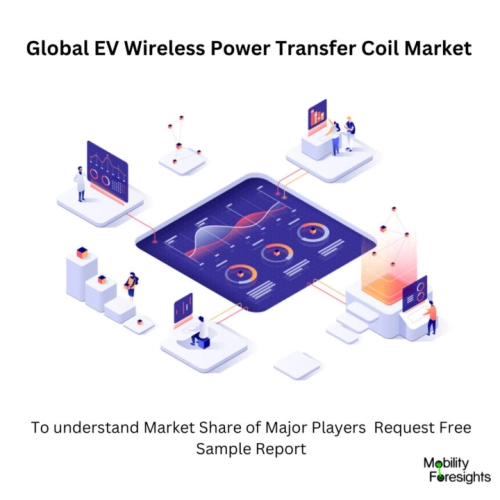
- Get in Touch with Us

Last Updated: Apr 25, 2025 | Study Period: 2024-2030
Electric cars (EVs) and hybrid electric vehicles (HEVs) use wireless power transfer coils, sometimes referred to as wireless charging coils or inductive charging coils, as essential parts to enable wireless charging of the vehicle's battery.
These coils are a component of the wireless power transfer system, which dispenses with physical contact and conventional charging connections to enable electrical energy to be transferred between a charging pad or station and the vehicle.
Here are several critical EV wireless power transfer coils features:
Induction concept: Electric vehicle (EV) wireless power transfer coils use the electromagnetic induction concept to transmit electrical energy wirelessly. When alternating current (AC) is passed via the primary coil in the charging pad or station, a magnetic field is created.
The vehicle's internal EV wireless power transfer coil serves as the secondary coil and picks up the magnetic field to induce an alternating current.
Coil Design and Construction: High-conductivity wire, like copper, is often used to create multi-turn, flat coils for EV wireless power transfer. In order to maximize the magnetic field coupling between the primary and secondary coils and the effectiveness of power transfer, the coils are meticulously coiled and positioned.
Efficiency of Wireless Power Transfer: The layout and positioning of the wireless power transfer coils affect the overall effectiveness of the charging procedure. The efficiency of power transfer is influenced by variables such coil size, spacing between coils, coil quality, and system design. Less energy is lost during the wireless charging process due to higher efficiency.

The Global EV Wireless Power Transfer Coil Market accounted for $XX Billion in 2023 and is anticipated to reach $XX Billion by 2030, registering a CAGR of XX% from 2024 to 2030.
New Wireless Power Pattern Coil from TDK, the MP-A28: A thin copper coil design has additional advantages for system performance. The physical separation between the transmit (Tx) and receive (Rx) magnetic shields affects magnetic coupling (K).
This causes the MP-A28 coil shield to be closer to the charge surface and the Rx device, boosting magnetic coupling and efficiency as a result of the ultra-thin coil pattern. Weight reduction continues to be a hot topic, particularly as manufacturers of electric vehicles work to increase the battery life and driving distance of their vehicles.
The thinness capability of the wet process/higher permeability material enables TDK's MP-A28 coil to reduce the weight of the Tx coil while preserving the necessary charging performance.
Consistency of electrical parameters - The MP-A28 A thin copper coil design has additional advantages for system performance. The physical separation between the transmit (Tx) and receive (Rx) magnetic shields affects magnetic coupling (K).
This causes the MP-A28 coil shield to be closer to the charge surface and the Rx device, boosting magnetic coupling and efficiency as a result of the ultra-thin coil pattern.
| Sl no | Topic |
| 1 | Market Segmentation |
| 2 | Scope of the report |
| 3 | Abbreviations |
| 4 | Research Methodology |
| 5 | Executive Summary |
| 6 | Introduction |
| 7 | Insights from Industry stakeholders |
| 8 | Cost breakdown of Product by sub-components and average profit margin |
| 9 | Disruptive innovation in the Industry |
| 10 | Technology trends in the Industry |
| 11 | Consumer trends in the industry |
| 12 | Recent Production Milestones |
| 13 | Component Manufacturing in US, EU and China |
| 14 | COVID-19 impact on overall market |
| 15 | COVID-19 impact on Production of components |
| 16 | COVID-19 impact on Point of sale |
| 17 | Market Segmentation, Dynamics and Forecast by Geography, 2024-2030 |
| 18 | Market Segmentation, Dynamics and Forecast by Product Type, 2024-2030 |
| 19 | Market Segmentation, Dynamics and Forecast by Application, 2024-2030 |
| 20 | Market Segmentation, Dynamics and Forecast by End use, 2024-2030 |
| 21 | Product installation rate by OEM, 2023 |
| 22 | Incline/Decline in Average B-2-B selling price in past 5 years |
| 23 | Competition from substitute products |
| 24 | Gross margin and average profitability of suppliers |
| 25 | New product development in past 12 months |
| 26 | M&A in past 12 months |
| 27 | Growth strategy of leading players |
| 28 | Market share of vendors, 2023 |
| 29 | Company Profiles |
| 30 | Unmet needs and opportunity for new suppliers |
| 31 | Conclusion |
| 32 | Appendix |